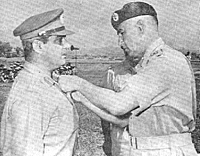For the attack, the Pakistani Army concentrated 102nd Infantry Brigade, under Brigadier-General Zafar Ali Khan, the 4th Azad Kashmir Brigade, under Brigadier-General Abdul Hameed Khan, and the 10th Infantry Brigade, under Brigadier Hayat. Also added were two companies of 12th Frontier Force Regiment. All told, a total of seven infantry battalions were committed to the counterattack.
The armoured component consisted of two armoured regiments, the 11th Cavalry and the 13th Lancers. 4th Corps Artillery of some 40 field, 40 medium, and eight 8-inch guns made up the artillery component. Overall, this force was under the command of Pakistan's 12th Division commander, Major-General Akhtar Husain Malik. Everything was ready by 1st September 1965.
This force concentrated on a narrow front in the area of Bhimber and opened with superb tank, infantry, and artillery co-ordination. A heavy artillery bombardment of 90 minutes began at 0300 hours, immediately followed at first light by the ground assault. By mid-afternoon the Pakistani force had rapidly advanced as far as Chhamb and Dewa.
The Indian army called in air support--four Vampire aircraft. The Pakistan Air Force (PAF) reacted by sending a pair of F-86 Sabre fighters. Within minutes, all four Indian Vampire aircraft were shot down with no losses to the PAF--each PAF pilot was credited with two kills. The Indian Air Force (IAF) learned a lesson in air superiority that day by sending in unescorted Vampires without first gaining air superiority. Indeed, the IAF never again employed Vampires in combat during the battle.
Indian defences continued to crumble under the Pakistani onslaught, and by night of 1st September, Pakistani troops had captured Chhamb, stopping on its side of the River Munawwar Tawi. Credit belonged to General Akhtar Malik for his superb leadership and planning of this operation.
Change of Command, Change of Fortune
 Then came the chanage in command, when General Malik was replaced by Major-General Yahya Khan of the 7th Infantry Division. Why was General Malik replaced when he was performing superbly and advancing at lightning pace? According to Pakistan Army High Command, he was urgently needed to shore up the northern Kashmir flank than in the south around Chhamb.
Then came the chanage in command, when General Malik was replaced by Major-General Yahya Khan of the 7th Infantry Division. Why was General Malik replaced when he was performing superbly and advancing at lightning pace? According to Pakistan Army High Command, he was urgently needed to shore up the northern Kashmir flank than in the south around Chhamb.
Gen. Musa decorating Maj. Gen. Yahya Khan (7th Division) with the Hilal-e-Jurat, from the Pakistan Army War 1965.
Operation Grand Slam was conceived in response to relieve pressure on the northern front, and was only partially successful. Hence, Malik was sent for.
Whatever the cause, this command change was a mistake, for it wasted valuable time and slowed Pakistani momentum. Under the new commander, the Pakistani Army continued its advance by crossing the River Munnawar Tawi at 1730 hours on 2nd September. The 10th Brigade, consisted of the 6th Bn. Frontier Force Regiment, the 14th Punjab Battalion, and the 13th Lancers (armour regiment), crossed the river and created a bridgehead for a breakout to follow the fleeing Indian Army units.
10th Brigade under Brig. Gen. Hayat moved swiftly and its 14th Punjab Battalion soon attacked Indian positions at Jaurian. Although the Indian 41st Brigade held on to Jaurian until the 4th, it fell back into the strong defence perimeter around Akhnur manned by the Indian 191st Brigade. Hayat brought up the 6th Bttn. Frontier Force to join the assault on the Indian rearguard troops in Jaurian, and Pakistani troops finally captured the town on the 5th.
Now Pakistani troops were poised to capture Akhnur. If Akhnur fell to the Pakistanis, the strategically vital Jammu-Rajouri road would be cut and Indian forces in occupied Kashmir would be totally cut off from India. The Indian Army knew how critical its position in Kashmir had become, and decided to launch a full-fledged attack into Pakistan at Lahore and Sialkot to ease pressure in the Akhnur sector.
The defence of Pakistan itself came first and the troops involved in Operation GRAND SLAM were soon transferred to the Lahore and Sialkot fronts. The Pakistani Army in Kashmir assumed the defensive. Even with new attacks against Pakistani territory, the Indian Army also made strong efforts in Kashmir to regain lost territory. Between 6 to 10 September, it launched several attacks, but Pakistani defenders repulsed the attacks with heavy Indian losses and kept what they had captured.
Overall
Overall, Operation Grand Slam was a remarkable success for the Pakistani Army. It had captured large areas of territory in Kashmir and came close to capturing all of Kashmir.
One critical Pakistani decision, the change in command from Malik to Khan, wasted a day. Instead of continuing the counter-attack on the morning of 2 September, the pursuit of the defeated Indian army only resumed very late in the afternoon, providing the Indian Army with precious time to adjust and strengthen their defensive positions. Akhnur, the vital Jammu-Rajouri road, and half of Kashmir remained in Indian hands.
BIBLIOGRAPHY
Cloughley, Brian, A History Of The Pakistan Army: Wars and Insurrections, Karachi: Oxford University Press, 2000.
Musa, Mohammad. My Version: India-Pakistan War 1965, Lahore: Wajidalis Limited, 1983.
Riza, Major-Gen. Shaukat. The Pakistan Army War 1965.
Map

Pakistan's Thrust into Kashmir 1965
Back to Table of Contents -- Pakistan At War Newsletter 2
Back to Pakistan At War Newsletter List of Issues
Back to MagWeb Magazine List
© Copyright 2002 by Shahram Khan.
This article appears in MagWeb (Magazine Web) on the Internet World Wide Web.
Other military history articles and gaming articles are available at http://www.magweb.com